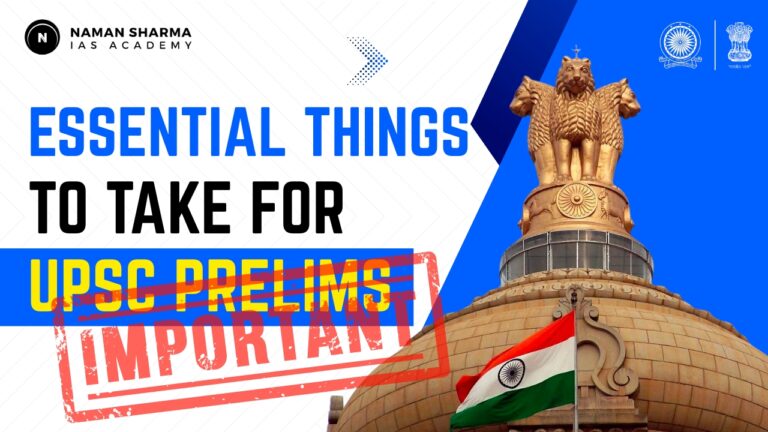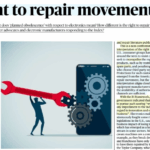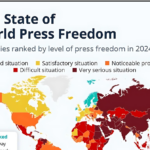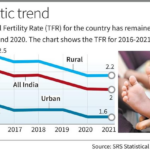The Right to Repair Movement in India
The Right to Repair Movement in India pushes for consumer rights, reduced e-waste, and fair access to repair devices without manufacturer restrictions.
Recently, the Department of Consumer Affairs (DoCA) announced that a report for a “Framework on Repairability Index (RI) in Mobile and Electronic Sector” had been submitted to the government. Apple’s surprising reversal on the “right to repair” movement holds immense significance, considering it was previously among the tech giants opposing the concept. Apple now supports legislation granting consumers and third-party firms the right to fix damaged electronic products. This shift aligns with a broader trend of tech companies adapting to consumer demands for greater control over their devices.
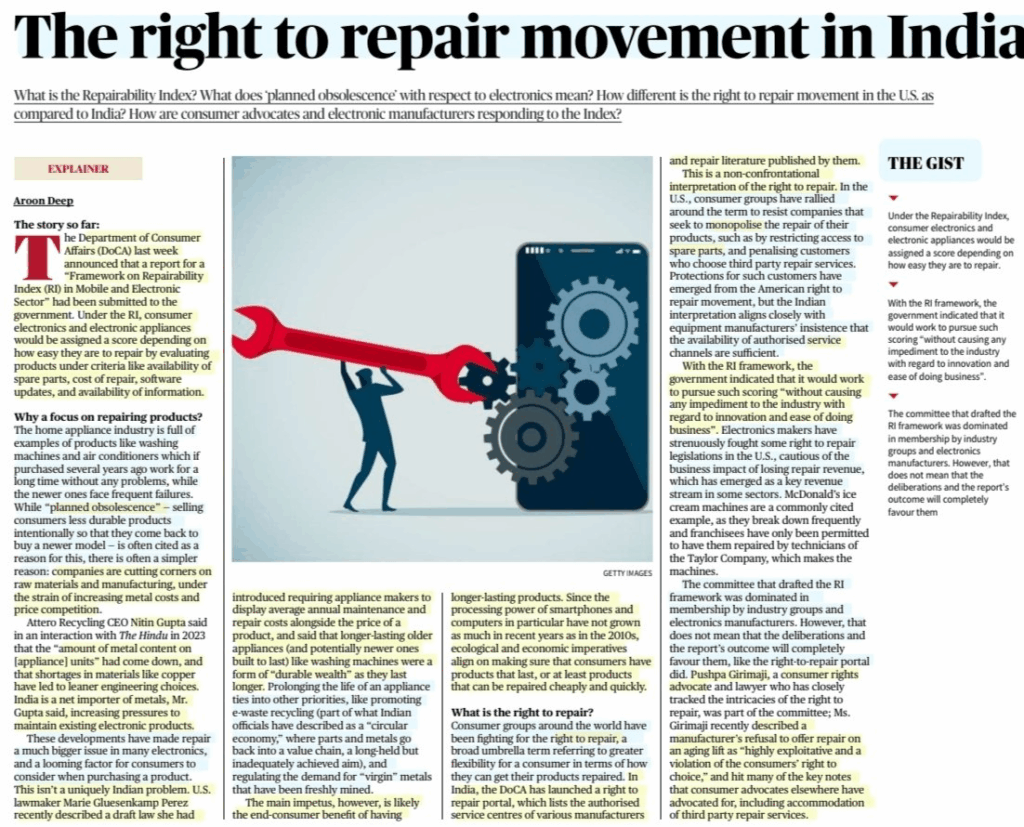
About Right to Repair:
Background
- Earlier, the Union government set up a committee (headed by Nidhi Khare) to develop the “comprehensive framework” on the Right to Repair. The sectors identified include Farming Equipment, Mobile Phones/ Tablets, Consumer Durables and Automobiles/Automobile Equipment.
- The framework is an attempt to reduce restrictive practices implemented by some manufacturers in order for consumers to repair goods such as consumer durables, phones, and automobiles on their own.
- The framework will become a “game-changer” for the sustainability of the products and catalyse employment generation. The Right to Repair refers to government legislation that is intended to allow consumers the ability to repair and modify their own consumer electronic devices, where otherwise the manufacturer of such devices requires the consumer to use only their offered services. India has taken a notable step toward empowering consumers and ensuring environmental sustainability through its Right to Repair movement.
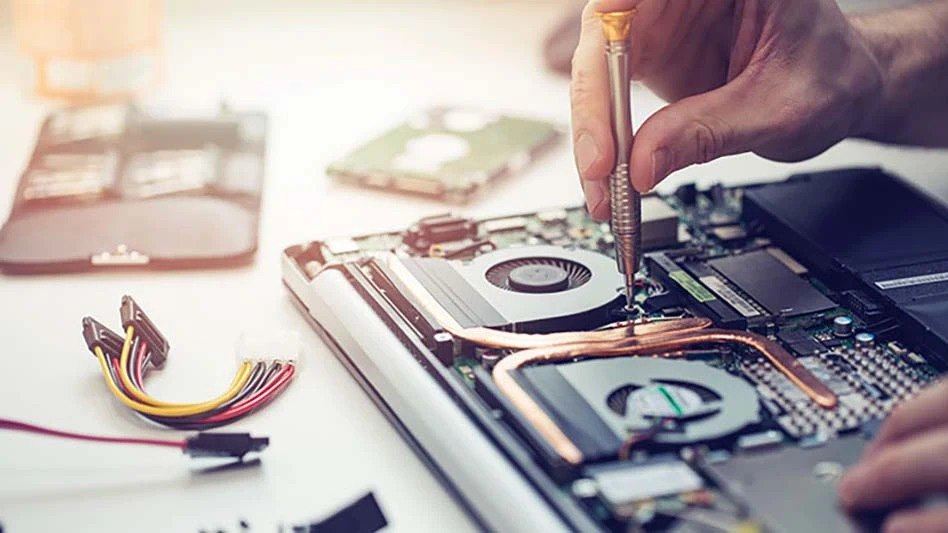
- The Department of Consumer Affairs (DoCA) recently accepted a report on the proposed Repairability Index (RI)for mobile phones and electronic appliances, which aims to rank products based on how easy they are to repair. When customers buy a product, it is inherent that they must own it completely, for which the consumers should be able to repair and modify the product with ease and at a reasonable cost, without being captive to the whims of manufacturers for repairs.
- Origin of the Idea: The idea originally originated from the USA, where the Motor Vehicle Owners’ Right to Repair Act 2012 required the manufacturers to provide the necessary documents and information to allow anyone to repair their vehicle. In the United States, the Right to Repair movement has gained legislative support, especially against practices like:
- Restricting access to spare parts
- Locking devices with proprietary software. Penalising third-party repairs
- Laws have been introduced requiring companies to publish repair costs and ensure access to spare parts. In contrast, Indian policy is still evolving, with more collaboration between the government and manufacturers.
- One notable example is McDonald’s in the U.S., where only Taylor Company technicians are allowed to repair the brand’s ice cream machines, leading to consumer frustration and regulatory scrutiny. Similar monopolistic repair models in electronics are being questioned globally.
This framework, aligned with the global right to repair movement, is a response to rising concerns about product durability, electronic waste, and consumer dependence on manufacturers for repairs.
Repairability Index:

- The proposed Repairability Index is a score that evaluates how easy it is to repair a product. It considers criteria such as:
- Availability and pricing of spare parts
- Access to repair documentation
- Cost and time of repairs
- Software support : Consumer electronic products and appliances like smartphones, washing machines, and refrigerators would be rated using this index, allowing consumers to make informed purchase decisions. The idea is to promote long-lasting products and provide transparency regarding repair options.
Right to Repair Movement in India
- Globally, the right to repair refers to the consumer’s ability to choose how and where to repair their devices, whether through the manufacturer or independent service providers. In India, the DoCA launched a Right to Repair Portal, listing: Manufacturer-authorised service centres
Repair manuals and guides
- Unlike the more confrontational stance in countries like the U.S., India’s model currently supports manufacturer-authorised channels, with limited support for third-party repairs.
- However, the inclusion of consumer rights advocates suggests the framework may not be entirely in favour of manufacturers. They emphasised that denying repair services for older products violates the consumer’s right to choice and advocated for more repair freedom.
Global Context and U.S. Comparison
- In the United States, the Right to Repair movement has gained legislative support, especially against practices like: Restricting access to spare parts, Locking devices with proprietary software Penalising third-party repairs.
- Laws have been introduced requiring companies to publish repair costs and ensure access to spare parts. In contrast, Indian policy is still evolving, with more collaboration between the government and manufacturers.
- One notable example is McDonald’s in the U.S., where only Taylor Company technicians are allowed to repair the brand’s ice cream machines, leading to consumer frustration and regulatory scrutiny. Similar monopolistic repair models in electronics are being questioned globally.
Conclusion
- The Right to Repair movement in India marks a pivotal shift toward consumer empowerment, product sustainability, and environmental consciousness. As India inches closer to a formal framework with initiatives like the Repairability Index, it acknowledges the pressing need to break monopolistic control over repair services and reduce electronic waste.
PRELIMS PRACTICE QUESTION
Question: Which of the following statements best represents the multifaceted challenges and evolving structure of the Right to Repair movement in India in contrast to global practices?
- The Indian Right to Repair framework, while rooted in global ideals, currently limits third-party access and prioritises manufacturer-authorised repair models.
- The Repairability Index in India is intended to be legally binding from its inception and will immediately penalise companies not complying with consumer repair transparency.
- The U.S. Motor Vehicle Owners’ Right to Repair Act (2012) served as a foundational influence, advocating mandatory access to repair information for independent service providers.
- Unlike the U.S., India’s current policy framework lacks any active legislation mandating the disclosure of repair costs or compulsory spare part access for consumers.
- India’s Right to Repair Portal currently hosts manuals, guides, and third-party service directories to empower consumers equally with manufacturers.
- The movement in India aspires to balance economic growth, employment generation, sustainability, and consumer rights while gradually dismantling monopolistic repair practices.
Choose the most appropriate combination:
A. 1, 3, 4, and 6
B. 1, 2, 3, and 5
C. 2, 3, 4, and 5
D. 1, 3, 5, and 6
E. 2, 4, 5, and 6
F. 1, 2, 4, and 6
Correct Answer: A. 1, 3, 4, and 6
Explanation:
- Statement 1 Correct:
- India’s model is still manufacturer-centric, with limited third-party repair support
- Statement 2 incorrect:
- The Repairability Index is not legally binding yet; no enforcement punishment mechanisms exist.
- Statement 3 correct:
- The U.S. 2012 Act mandated repair info for third parties and influenced global discourse.
- Statement 4 Correct:
- India does not yet mandate repair cost disclosure or spare part access
- Statement 5 incorrect:
- The Right to Repair Portal lists only manufacturer-authorised services and repair manuals, not third-party directories
- Statement 6:
- The framework aims for a balanced approach: sustainability, jobs, and consumer rights
MAINS PRACTICE QUESTION
Question: The Right to Repair movement in India reflects a critical turning point in consumer rights and sustainability policy. Examine the challenges and opportunities in implementing a robust Right to Repair framework. Compare India’s approach with global practices, especially that of the United States.”(Answer in 250 words)

